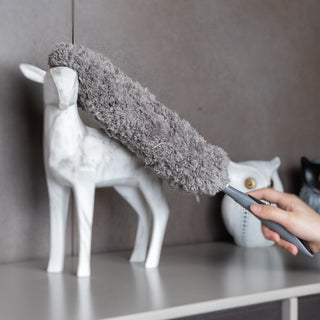Cleaning your duster isn't just about keeping it looking good; it's about ensuring it works effectively to pick up dust and allergens around your home. Here's a simple, step-by-step guide to keeping your duster not just clean but also durable.
Why Clean Your Duster?
Before we jump into the cleaning process, let's understand why it's important to regularly clean your duster. Dusting tools trap and hold dust, hair, and other particles, which can make them less effective over time. Regular cleaning removes these particles, ensuring your duster works as efficiently as possible.
5 Steps to Clean Your Dusting Tool
Step 1: Shake It Off
Start by shaking out the duster vigorously outdoors. This removes the loose dust and is especially effective for feather and wool dusters. A quick shake after every use can significantly reduce the buildup of dust.
Step 2: Hand Wash for a Deep Clean
For a thorough clean, hand washing is usually best. Fill a bucket or sink with warm water and add a mild detergent. Swirl your duster in the water, gently working the suds into the fibers. For microfiber dusters, this method is particularly effective as it helps maintain the static charge that attracts dust.
Step 3: Rinse Thoroughly
After washing, rinse the duster thoroughly under running water until the water runs clear. For feather dusters, be gentle to avoid damaging the feathers. Ensure that all soap is removed as any residue can reduce the duster's effectiveness.
Step 4: Air Dry
Once rinsed, shake out the excess water and reshape the duster. Hang it up or lay it flat to air dry. Avoid using a tumble dryer as the heat can damage the fibers, especially for microfiber and feather dusters.
Step 5: Storage
Store your duster in a dry, ventilated area. Avoid cramping it in a closet or drawer, as that can deform the shape and reduce its effectiveness. Hanging it is usually the best option to maintain its shape.
When to Replace Your Duster?
No matter how well you maintain it, over time, your duster will wear out. If you notice it's not picking up dust as effectively or the fibers are damaged, it might be time for a new one.
Replace your duster when it no longer effectively picks up dust or after about 2 years of regular use for most types, whichever comes first. For disposable dusters, replace them when they appear visibly dirty or lose their dust-trapping effectiveness. For washable microfiber dusters, if they still don't effectively trap dust after washing, it's time to get a new one. Always follow the manufacturer's specific recommendations for the best results.
Tips for Maintaining Your Duster
1. Regular Shaking: Maximize Dust Release
Technique: After each use, take your duster outside or over a trash bin and give it a vigorous shake. Make sure to grip the handle firmly and flick your wrist briskly back and forth to dislodge as much dust as possible.
Benefits: Regular shaking helps maintain the duster's dust-grabbing capabilities and extends its lifespan by preventing dust buildup.
2. Avoid Fabric Softener: Maintain Microfiber Efficiency
Why Avoid?: Fabric softeners coat fibers, reducing their natural static charge. This static charge is crucial for microfiber dusters as it helps attract and trap dust particles.
Alternative: If you feel the need to soften your duster, use a cup of white vinegar in the rinse cycle as a natural fabric softener alternative.
Care Tip: Always read the label on your microfiber duster to confirm the manufacturer's recommendations, as some may suggest specific washing instructions.
3. Check the Care Instructions: Understand Material Needs
Each duster type, whether feather, wool, or synthetic, has unique care requirements. For instance:
Feather Dusters: Might need more gentle cleaning methods. Avoid harsh chemicals and consider using a mild detergent or just water for washing.
Microfiber Dusters: Wash separately or with like materials to maintain effectiveness; avoid mixing with cotton or other lint-producing fabrics.
Wooden Handles: If your duster has a wooden handle, avoid submerging it in water to prevent warping or rotting. Wipe it down with a slightly damp cloth instead.
Storage Conditions: Read the label for storage tips. Generally, hang dusters in a cool, dry place away from direct sunlight to prevent damage to the fibers or the handle.
Replacement Signs: Look out for signs of wear and tear, such as fraying edges or persistent odors, which indicate it's time for a replacement.
Cleaning your duster regularly ensures that your home stays cleaner and dust-free. It's a simple task that can make a big difference in the effectiveness of your cleaning routine. So next time you finish dusting, give your duster a little TLC!


